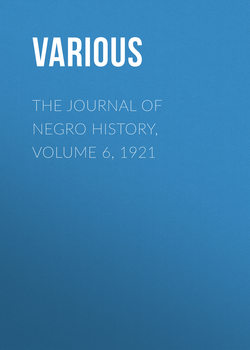Читать книгу The Journal of Negro History, Volume 6, 1921 - Various - Страница 15
The Journal of Negro History
Vol. VI—January, 1921—No. 1
PROCEEDINGS OF THE ANNUAL MEETING, WASHINGTON, D. C., NOVEMBER 18, AND 19, 1920
ОглавлениеThe annual meeting of the Association for the Study of Negro Life and History was called to order by Dr. C. G. Woodson, the Director of Research and Editor of the Journal of Negro History. After a few preliminary remarks, President John W. Davis of the West Virginia Collegiate Institute was asked to open the meeting by the invocation of divine blessing. Professor William Hansberry of Straight College was introduced to deliver a lecture on the Ancient and Mediaeval Culture of the People of Yorubuland. This was a most informing disquisition on the achievements of these people prior to the time when they came into contact with the so-called more advanced Asiatic and European races. On the whole, Professor Hansberry made a strong argument in behalf of the contention that the culture of these people was indigenous and that brought into comparison with that of the ancient Greek and Roman it does not materially suffer.
Mr. A. O. Stafford, the principal of the Lincoln School of Washington, D. C., then read a very illuminating and informing paper on African folk lore. He discussed briefly the various authorities producing works in this field and indicated sources of information which have not yet been explored. He then made a general survey of African folk lore, showing how the Negro mind from the very earliest periods of African history exhibited independent thought and philosophical tendency.
At the conclusion of these addresses there followed a general discussion in which participated Principal D. S. S. Goodloe of the Maryland State Normal and Industrial School, Mr. John W. Cromwell, President of the American Negro Academy, Mr. Monroe N. Work, Director of Research and Records, Tuskegee Institute, and President John W. Davis of the West Virginia Collegiate Institute.
At two o'clock the Association held a business session. The general routine of business was followed. There being no unfinished business or reports of special committees, the Association heard the reports of the officers of last year. The Director read his report and the report of the Secretary-Treasurer was presented by his assistant, Miss A. H. Smith. They follow:
The Report of the Director
During the year 1919-1920 the Association has made steady progress in spite of the difficulties resulting from the increasing cost of labor and supplies. There has been some difficulty in raising additional funds adequate to the needs of the Association and for this reason the organization is now suffering from a deficit of about $2500. Persons of means, however, have from time to time volunteered so as to give sufficient relief to keep the work going. Efforts are now being made to remove this deficit in the near future through the increase in the contributions annually received and gifts from other friends who will be asked to make sacrifices for the cause.
The study of Negro history has not extended by leaps and bounds but the progress of the work is in every way encouraging. The number of subscribers to the Journal of Negro History has not increased because of the necessity to double the subscription price in keeping with the demands of high prices, but the influence of the work has considerably expanded. This magazine is now being used as collateral reading in most of the leading white and Negro institutions of the country and the number of classes thus engaged are increasing every year. There is also a healthy public opinion in favor of prosecuting the study of Negro history more vigorously. Almost any book setting forth facts as to what the Negro has thought and felt and done now has considerable demand among persons in this country and abroad. While this Association does not claim credit for all which has been accomplished in this field, it has certainly given a decided stimulus to the work.
It will be interesting to report, moreover, the number of institutions closely cooperating with the Association in prosecuting the study of the Negro. Among these may be mentioned special classes in this work at Howard University, conducted by the Director himself last year, and at the West Virginia Collegiate Institute, where he is now engaged. In Lincoln Institute, Missouri, considerable good has been accomplished among students even of a high school grade, whereas at the State Normal and Industrial Institute at Frankfort, Kentucky, the work has interested a larger number of more advanced students. Institutions like Straight College, Fisk, Atlanta, Morehouse, Wilberforce, and Lincoln are laying a good foundation in this field.
Report of the Secretary-Treasurer
The Association for the Study of Negro Life and History, Incorporated, Washington, D. C.
Gentlemen: I hereby submit to you a report of the amount of money received and expended by the Association for the Study of Negro Life and History, Incorporated, from September 30, 1919 to September 30, 1920, inclusive:
Respectfully submitted,
Alethe H. Smith
Assist. to the Secretary-Treasurer.
After a brief discussion these reports were accepted and approved. The Association then spent some time in discussing the advisability of holding annual meetings at strategic points and there prevailed a motion to the effect that the Executive Council be requested to hold the next annual meeting of the Association in Atlanta, Georgia. The meeting adjourned after electing the following as officers: Robert E. Park, President, Jesse E. Moorland, Secretary-Treasurer, Carter G. Woodson, Director of Research and Editor; who with Julius Rosenwald, George Foster Peabody, James H. Dillard, John R. Hawkins, Emmett J. Scott, William G. Willcox, Bishop John Hurst, Albert Bushnell Hart, Thomas Jesse Jones, A. L. Jackson, Moorfield Storey, and Bishop R. E. Jones, were made members of the Executive Council.
